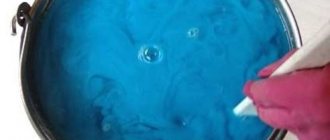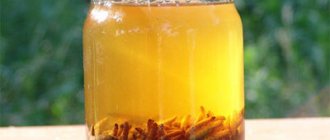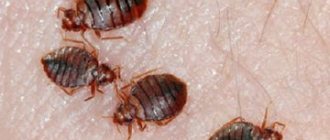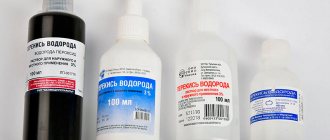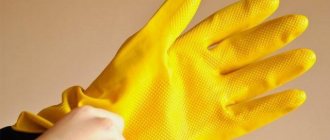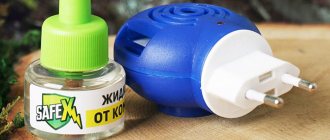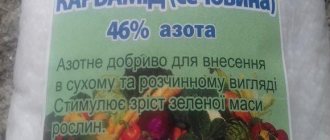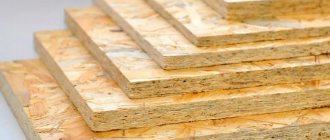There are a huge number of plant protection products on the modern market, but not all of them are absolutely safe for humans. Bordeaux mixture, which has been used by gardeners and gardeners for many decades, is considered one of the most popular and harmless remedies.
Despite the fact that this substance is considered safe for humans, you need to know how to properly prepare the working solution and use it. These nuances will be revealed in today's article.
- For trees
Description and characteristics of Bordeaux mixture
The mixture is an effective fungicide that has been successfully used to protect plants for more than a century. In fact, the substance is a mixture of several components, since it consists of copper sulfate and slaked lime, which must be diluted with water (Figure 1).
Figure 1. The fungicide consists of two components: copper sulfate and slaked lime
Each of these components has a beneficial effect on plants individually, but together they turn into a powerful protective agent with proven effectiveness.
This powder composition helps to perfectly protect crops from fungal and bacterial diseases, and it can be used for both treatment and prevention.
How to prepare the solution
We recommend reading our other articles
- Indoor Jasmine flower
- Chilli
- Cherry variety Lyubimitsa Astakhova
- The best goat breeds
Bordeaux mixture is sold in packages containing copper sulfate and lime in different bags. To make a working solution, these ingredients are mixed with clean water in the correct concentrations. In gardening and gardening, a solution of 1% and 3% is popular. How to dilute the drug is described below.
Solution 1%
To make a 1% solution, you need to pour 50 g of copper sulfate with a liter of warm water. In a separate container (not metal), you need to dissolve 150 g of lime in a liter of water. Now the solution of copper sulfate is poured into a container with lime and mixed. All that remains is to bring the resulting mass to 5 liters (by adding plain water).
To make a working solution, the ingredients are mixed with clean water in the correct proportions.
Important!
Before pouring the solution into the sprayer, it is recommended to filter it, because lime components may precipitate.
Solution 3%
This solution is made in exactly the same way as 1%, only the concentration of substances required is different. 150 g of copper sulfate must be dissolved in 1.5 liters of water, and 350 g of lime must be diluted in 2.5 liters of water in another container. Now the liquids are mixed and cold water is added so that the final volume of the solution is 5 liters.
Area of application
Most often, Bordeaux mixture is used to combat pathogens of various diseases, but the product should be used strictly according to the instructions so that an excess of chemicals does not cause harm to plants (Figure 2).
In gardening, this substance is used both in autumn and spring for:
- Spraying stone fruit crops as a preventive measure against various rots and spots.
- Treatments of grapes to eliminate symptoms and prevent powdery mildew and black rot.
- Spraying agricultural crops, in particular tomatoes and potatoes against late blight, onions against rot, and beets against rust and cercospora.
- Treatments of pome trees (apple trees, pears, etc.) for treatment and prevention against scab, fruit rot, bacterial cancer and spotting.
Figure 3. Fungicide is used to protect plants from diseases.
In addition, the liquid is used for spring treatment of fruit and ornamental shrubs and coniferous crops.
Treatment can also be carried out in August, when most crops enter a period of vegetative dormancy. Such
Operating principle
Bordeaux mixture has a fairly simple principle of action, which is based on the characteristics of its components.
Note: Copper sulfate itself is a poison, and lime is its neutralizer. Together they destroy pathogenic microorganisms without harming the plant itself.
The sprayed plant not only receives reliable protection from bacteria and fungi, but is also saturated with copper, which contributes to the proper development of the crop. Typically, a deficiency of this element is observed in acidic and peaty soils, and the crop itself becomes weakened and more susceptible to disease.
It should be taken into account that the working solution must be prepared and sprayed only in strict accordance with the instructions. Otherwise, the plant may get leaf burns and even die.
Advantages and disadvantages
Despite its effectiveness in combating plant diseases, the liquid is still a potent chemical, so before using it you need to carefully study the pros and cons of this product.
The advantages of the fungicide include:
- Highly effective in combating common diseases of horticultural crops with the financial accessibility of the components of the product.
- Long-lasting effect of the prepared mixture: if you spray plants for prevention, the effect of the mixture will last for 30 days.
- Ease of preparation of the working solution and its versatility.
In addition, the finished mixture adheres well to the leaves and shoots of plants, eliminating the possibility of re-infection.
However, along with its advantages, the liquid also has certain disadvantages. Firstly, it should be borne in mind that the mixture is toxic and, if used incorrectly, is harmful to humans. For this reason, when preparing and using the working solution, it is imperative to use personal protective equipment.
Secondly, spraying should be carried out strictly according to the instructions, and the number of treatments should not exceed the norm. In the first case, plants may suffer from excess chemicals, and in the second, copper will begin to accumulate in the soil and negatively affect the growth and productivity of crops.
Bordeaux liquid
- Protects against scab, moniliosis, coccomycosis, fruit rot and various spots.
- Easy to use, just dilute with water.
- Does not cause burns on plants.
Packing:
100 ml, 500 ml (bottle)
Wholesale order conditions
- The order is available only for legal entities
- Order from 1 box
- Cashless payment only
- Flexible discount system
Go to bulk order
Delivery
Available in Moscow and the Moscow region with an order amount of 100,000 ₽
Pickup
from warehouse Moscow region, Kotelniki, Silikat district, building 4 Show on map
Result of the drug
Apple tree, pear tree
Plum, cherry, sweet cherry, apricot
Black currant, gooseberry
Active substance:
172 g/l tribasic copper sulfate.
Preparative form:
VSK is a water-suspension concentrate.
Manufacturer:
AO, Russia.
Security measures:
- Carry out the treatment in the absence of children and animals.
- Work in clothing, gloves and a respirator specially designed for this purpose.
- Store the drug separately from medications, food and animal feed in a dry, cool place out of reach of children and animals.
- Drink, eat, smoke during treatment.
- Use dishes (containers) for food and drinking water to prepare working solutions.
- Mix with other pesticides.
Features of application
We have provided instructions for preparing solutions of different concentrations for good reason, because a 3% solution is used for spraying either in early spring or late autumn. At all other times, only a one percent solution should be used.
In addition, the use of Bordeaux mixture also depends on the type of crop that you are going to spray, so we will pay attention to these nuances.
For trees
Spraying trees with Bordeaux mixture has its own characteristics. For both stone fruit and pome crops, a 3% solution is used only in early spring, before the buds swell, and for treating the garden in late autumn (Figure 5).
Figure 5. Trees are sprayed in early spring or late autumn
During the active growing season, trees can be sprayed with only a 1% solution, and no more than 10 liters of working solution should be used per adult specimen, and a maximum of two liters per young specimen. Apple trees can be treated no more than 6 times a season, but it is generally advisable not to spray stone fruits (apricots, peaches, etc.) during the growing season.
For grape bushes
Bordeaux mixture for spraying grapes is used mainly in the spring, before the buds swell. It is this treatment that is considered effective against spotting. On average, about one and a half liters of 3% working solution is consumed per 10 square meters of plantings (Figure 6).
Figure 6. The substance not only protects grapes from diseases, but also increases its immunity
During the active growing season, it is advisable not to use the mixture, as it can slow down the growth of shoots and deteriorate the quality of the fruit. But, if disease symptoms do appear, the plantings can be treated once or twice with a one percent fungicide solution.
For vegetables
A one percent solution of Bordeaux mixture is also used to prevent plant diseases in the garden. For example, using this mixture you can process tomatoes in a greenhouse and open ground (Figure 7).
Note: No more than 2 liters of working solution are used per 10 square meters of planting, and no more than 4 sprayings can be carried out over the entire season.
Bordeaux mixture for processing potatoes can be used much more often - up to 14 sprays per season, although no more than a liter of a one-percent solution should be used per 10 square meters of plantings.
Figure 7. Bordeaux mixture - a safe and effective way to protect garden crops
Using this fungicide, you can also treat the soil allocated for growing cucumbers, watermelons, melons and beets. For these crops, no more than three treatments are carried out per season, and the consumption of a one-percent mixture per 10 square meters should be no more than a liter.
Flowers
Spraying with Bordeaux mixture also gives good results when treating roses and other flowers in the spring, before the buds swell. This procedure helps to avoid damage to crops by rust and spotting (Figure 8).
Figure 8. The drug allows you to timely prevent diseases of flowers and ornamental crops
For preventive treatment of ornamental crops, a one percent solution is also used. In addition, the recommended frequency of spraying should not be exceeded, as this may slow down the growth of plants and reduce their decorative value.
Berries and shrubs
Bordeaux mixture is widely used to protect berry bushes from various diseases. For example, a three percent solution is used to process currants and strawberries in the spring. The procedure must be carried out before the buds swell, and during the active growing season, no more than 3 sprayings can be carried out per season, using a one-percent mixture.
Regardless of the type of crops being processed, it should be remembered that ripe fruits are not suitable for food immediately after spraying. Fruits will be edible only 15 days after the procedure, vegetables – 20, and berries – 25 days after treatment.
What it is?
Bordeaux mixture is a simple and effective pesticide made from a mixture of calcium sulfate and copper hydroxide, which does not require special processing skills and can be easily made at home.
This substance easily copes with common diseases of cultivated plants and can be used for both preventive and medicinal purposes. The treatment process itself is simple and understandable to everyone - there is a clear schedule and rules for watering.
The mixture works very simply - it reacts with carbon dioxide in the air and releases copper sulfate, which is the main destroying factor for diseases.
Compound
If we consider the chemical formula, the mixture consists of calcium sulfate in the form of an aqueous solution and copper hydroxide. In practice, to prepare this pesticide, a farmer will need:
- copper sulfate,
- water,
- quicklime.
All these components can be purchased at any hardware store or at a point of sale of gardening goods.
Both ready-made Bordeaux mixture and the ingredients are sold separately.
For those who treat a large area, it is advisable to prepare the solution yourself - it will be cheaper. For those who process one or two crops, a ready-made mixture is also suitable.
Advantages of the product
This is a proven and effective remedy, which proves its great demand. It is actively used in gardening in the fall, and sales in summer are also at a high level. The pesticide is used by consumers of all types - from “serious” farmers with hectares of crops, to simple gardeners with small vegetable gardens and orchards.
IMPORTANT! Treatment, along with the “treatment” of diseases, also protects plants from pests.
The solution is also very easy to prepare and store at home - this is a very serious advantage, as is its price.
This pesticide is perhaps the main “autumn” remedy that protects crops that are almost ready for harvest. Any farmer knows that plants are no less vulnerable in the fall than in the spring, when their growth is just beginning.
Garden crops that are most often treated with Bordeaux mixture:
- Grape . The whimsical vine is practically a record holder for the number of diseases that are dangerous both for the fruit and for the plant itself.
- Currant . Currants of any kind grow well as long as they are not in any danger from the outside. At the slightest threat this is a very vulnerable plant.
- Raspberries . This shrub grows on its own in many farms, but in this case the demand for berries will be corresponding - raspberries are attacked by many pests.
- Fruit trees . The biggest mistake a novice gardener makes is to neglect treating trees, naively believing that they grow on their own.
Security measures
Despite the fact that the liquid is considered an effective and inexpensive fungicide, do not forget about some precautions when using Bordeaux mixture. First of all, it should be remembered that this substance has moderate toxicity, therefore both the preparation of the working solution and its use require the use of personal protective equipment.
It should be remembered that Bordeaux mixture cannot be mixed with soap or other fungicides, and the treatment itself cannot be carried out during rain or strong winds.
Useful tips
Observe the concentration of the prepared liquid. An incorrectly prepared solution of Bordeaux mixture, for example, when using your own lime, the concentration may be impaired. By treating plants with this solution, you can burn the leaves. If the concentration is less, you will not get the expected result after treatment. This can be checked using the litmus test included in the package.
The reaction must be neutral or slightly alkaline. This will be indicated by the paper turning blue. If it turns red, add some milk of lime to the solution and test again.
You can check the correct concentration of the solution in a simple way. Dip any iron object (nail, wire, knife, etc.) into the liquid. If there is excess copper, then red spots will remain on the surface - traces of copper. If not, then the solution is normal and can be used.
- When mixing, the solutions must be cooled, so you get a good working solution.
- It is forbidden to add water to a ready-made working solution.
- Spraying is best done using a special sprayer.
- Before spraying, be sure to filter the working solution.
- When spraying, wear protective clothing, gloves, a respirator or mask. After carrying out work, remove protective clothing and be sure to wash your hands and face.
- Use the prepared solution on the day it is prepared. The next day, the beneficial properties of the insecticide are lost.
- The treatment is carried out in dry and cool weather, since high humidity can cause leaf burns.
- Before treating with Bordeaux mixture, it is advisable to thoroughly wet the entire plant so that the liquid flows into all the cracks in the bark. This is where the largest number of fungi and bacteria, as well as pests, accumulate.
Fertilizer analogues
Novice gardeners and gardeners are often afraid to use this fungicide because of its toxicity, and begin to look for an effective substitute for Bordeaux mixture (Figure 9).
Figure 9. The most popular analogues of the drug
Analogues of this drug do exist. Bordeaux mixture can be replaced with the drugs Abigo-pik, Hom or Kuproxat. These drugs are equally effective, but preparing a working solution is much simpler. The drugs Oksikhom and Polykhom are considered more modern. They not only act on the affected areas from the outside, but also treat them from the inside. Bordeaux mixture, unfortunately, does not have this effect.

